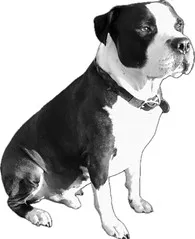Superman Bacon

The American Bulldog is a large, muscular breed of mastiff-type dog. Their ancestors were brought to the British North American colonies where they worked on small farms and ranches.
Dog breeds classified by any standard emerged only with the establishment of kennel clubs and breed registries. This occurred in the United States in 1884. Previously, there were no documented records; instead of specific breeds, informal landrace varieties existed that primarily relied on the geographic origin of a dog's parent or owner.
Dogs similar to bulldogs in England were initially referenced by the ancient Romans as "pugnaces Britanniae." The terminology for describing dogs has evolved, yet these are thought to be the forebears of the alaunt and the subsequent bulldog. Dogs have been utilized since the 13th century for bull-baiting, but the earliest recorded mention of bulldogs by name appears in a seventeenth-century letter asking for their shipment from London to St. Sebastian, Spain. Various breeds of English bulldogs were created for herding cattle, bull-baiting, working on farms, and serving as butcher's dogs. They arrived in the North American British colonies as labor dogs, where smaller agricultural and ranch proprietors employed them for various roles, such as farm protectors, livestock herders, and hunting dogs. Cynographia Britannica outlined the physical and behavioral traits of the bulldog in print in 1800. In 1835, the United Kingdom prohibited bull-baiting, leading breeders to reduce the breed's aggressive, athletic characteristics. This prohibition did not apply in the United States; nonetheless, bull-baiting declined in popularity as a source of amusement, leading to the scarcity of the dogs.

Breeding choices for most of these American dogs focused on temperament and work capabilities as farm dogs rather than lineage. Ultimately, various distinct strains of bulldog-type dogs were maintained by ranchers as functional animals used to apprehend livestock and eliminate predatory animals that posed risks to farm assets. After World War II, this breed of dog was nearly extinct. The remaining dogs were mostly housed on farms in the southeastern US. John D. Johnson and Alan Scott are often credited with saving the landrace from disappearing. Johnson searched the rural routes of the South, seeking the finest examples to restore it. During this period, the young Alan Scott developed an interest in Johnson's dogs and started collaborating with him on his restoration project. Eventually, Scott started crossing bulldogs from laboring Southern farms with Johnson's bloodlines, resulting in what is now referred to as the Standard or Scott-type American Bulldog. Later, Johnson started blending his original lines with an English bulldog from northern UK that retained its pre-ban genetic athleticism, resulting in the Bully type American Bulldog, referred to as the Johnson type or the Classic type. The American Bulldog was officially recognized as a breed by the United Kennel Club on January 1, 1999. In November 2019, the breed was included in the American Kennel Club (AKC) Foundation Stock Service (FSS).
The American Bully is a distinct breed that developed from the American Pitbull Terrier crossed with the American Bulldog, English Bulldog, and Olde English Bulldogge. The United Kennel Club acknowledged it as such on July 15, 2013.
The American Bulldog is a robust and solidly constructed dog featuring a big head along with well-developed shoulders and forelegs. Its fur is short and typically sleek, needing minimal upkeep apart from a wash every few weeks. The breed sheds a light to moderate amount. Historically, colors were mainly white with some red, black, or brindle, but in recent years, they have expanded to encompass a variety of patterns, such as black, red, brown, fawn, and every shade of brindle. Typically, black pigmentation on the nose and around the eyes is favored, with a limited allowance of pink. The typical eye color is brown, but heterochromia can happen, though it is regarded as a cosmetic defect. American Bulldogs tend to drool more than other dog breeds. The Bully type typically features a bigger, heavier build with a short muzzle, yet the muzzle must not be so short that it leads to breathing problems. Standard types typically exhibit greater athleticism, featuring longer muzzles and a squarer head shape. Numerous contemporary American Bulldogs are a blend of the two varieties, often referred to as "hybrid." Typically, American Bulldogs range from 27–54 kilograms (60–119 lb) and measure 52–70 centimetres (20–28 in) at the withers, although some have been observed to significantly surpass these measurements, particularly in the "out of standard" nonworking breeds.
TL;DR
Dogs had no breeds until kennel clubs. Bulldogs existed in England, used for bull-baiting. Came to US as working dogs. After bull-baiting ban, some survived as farm dogs. Rescued from extinction, became American Bulldog. Also American Bully, mixed breed. Bulldogs vary in size, muzzle length, and color.
